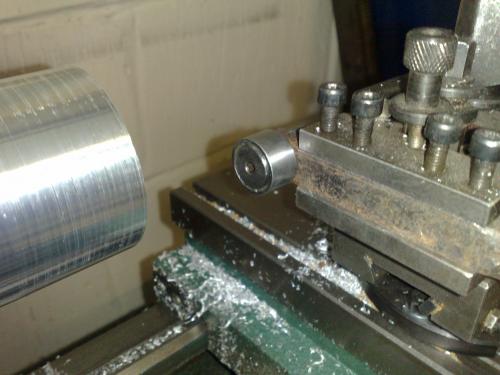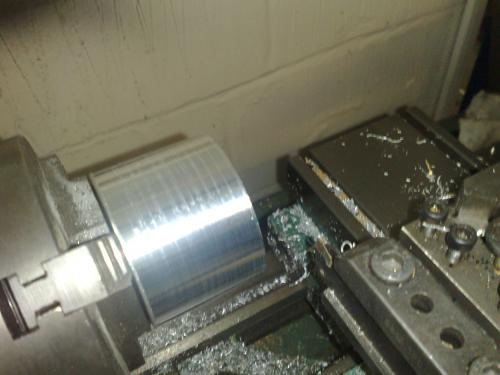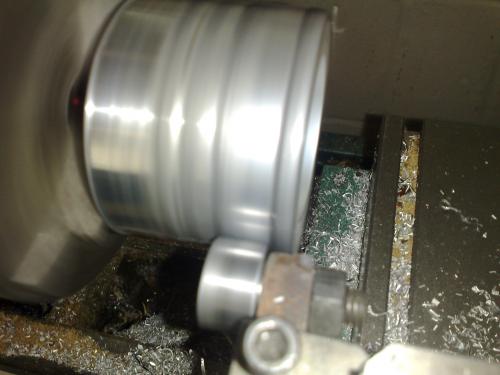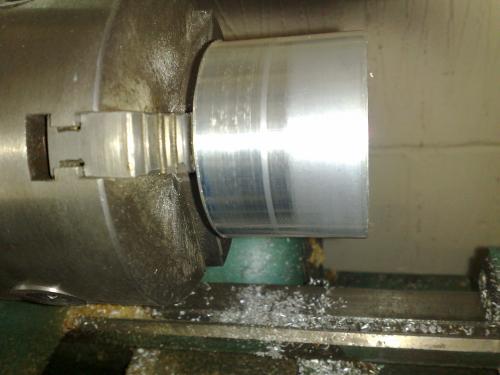07-02-2012, 07:19 AM
Long ago in a Forum a Far, Far away away,
OK, about eight months ago, while chatting on H-M about Knurling, DaveH and I started on about roller burnishing Aluminium in a lathe, Is it possible, what will the results be like etc,
At the time I was doing a little favour for a neighbour, when there just happened to be a left over track roller, a 3/4" diameter 3/8" wide roller bearing with integral 8mm mounting stud, I said I now had all the gear required to test the process, and Poooff, Some thing happened and DaveH vanished without a trace.
Anyway now that I've tracked him down again, when I spotted that track roller this morning I thought why not,
so I mounted a steel bar in the tool post and an 8mm drill in the three jaw chuck, while running the lathe at 800 Rpm I simply moved the carriage in towards the chuck drilling the mounting hole to take the 8mm stud,
I then simply slipped the stud into the hole, tightened the nut and presto, one roller burnishing tool.

The aluminium tube shown on the preceding photo is a piece of 60mm od x 10mm wall ally tube of unknown grade however I suspect it was 5083.
I had wanted to test on a pretty rough surface finish so i started with a standard turning tool in HSS but the finish was actually really good, almost "silky", so I went to carbide in the hope that the tip might tear the surface a little, no luck, smooth again
So how to get a dodgy finish, I tried this;

A carbide parting tool, the finish was still OK but it really "picked up" as I ran my finger nail across the surface,
So I went back to the roller burnisher, and using it just like a bump knurling tool, I proceeded to Knurl/Burnish, Burl? Knurnish? using machine way oil as a lubricant, just coating the surface with a squirt from an oil can.
Whatever it's called, I ran the machine at about 300RPM, brought the tool up to the surface and then applied about ten thou of preload, then fed along the piece at about 0.004"/Rev,

I did this three times and the result;

While the photos look like the Knurlished surface is less shiny than the machined surface, surface finish is about more than lustre, when I run my finger nail across this surface there are no hangups at all, it doesn't feel as smooth as silk it is just so smooth that it doesn't feel at all, the nail simply glides across.
the other benefit of burnishing apparently is that the grain boundaries are closed up by the process, not torn open as in machining, and also in rolling the boundaries closed in the presence of oil, locks some of that oil into the surface of the metal helping to guard against corrosion.
As far as dimensional changes go I could not measure any with my digital verniers, I will have a closer look later on with Mics but I feel that as the surface finish was not very rough before, there was only a very small movement of surface material so no great change in diameter.
So, I hope this of interest to some one out there,
Best regards
Rick
OK, about eight months ago, while chatting on H-M about Knurling, DaveH and I started on about roller burnishing Aluminium in a lathe, Is it possible, what will the results be like etc,
At the time I was doing a little favour for a neighbour, when there just happened to be a left over track roller, a 3/4" diameter 3/8" wide roller bearing with integral 8mm mounting stud, I said I now had all the gear required to test the process, and Poooff, Some thing happened and DaveH vanished without a trace.
Anyway now that I've tracked him down again, when I spotted that track roller this morning I thought why not,
so I mounted a steel bar in the tool post and an 8mm drill in the three jaw chuck, while running the lathe at 800 Rpm I simply moved the carriage in towards the chuck drilling the mounting hole to take the 8mm stud,
I then simply slipped the stud into the hole, tightened the nut and presto, one roller burnishing tool.
The aluminium tube shown on the preceding photo is a piece of 60mm od x 10mm wall ally tube of unknown grade however I suspect it was 5083.
I had wanted to test on a pretty rough surface finish so i started with a standard turning tool in HSS but the finish was actually really good, almost "silky", so I went to carbide in the hope that the tip might tear the surface a little, no luck, smooth again

So how to get a dodgy finish, I tried this;
A carbide parting tool, the finish was still OK but it really "picked up" as I ran my finger nail across the surface,
So I went back to the roller burnisher, and using it just like a bump knurling tool, I proceeded to Knurl/Burnish, Burl? Knurnish? using machine way oil as a lubricant, just coating the surface with a squirt from an oil can.
Whatever it's called, I ran the machine at about 300RPM, brought the tool up to the surface and then applied about ten thou of preload, then fed along the piece at about 0.004"/Rev,
I did this three times and the result;
While the photos look like the Knurlished surface is less shiny than the machined surface, surface finish is about more than lustre, when I run my finger nail across this surface there are no hangups at all, it doesn't feel as smooth as silk it is just so smooth that it doesn't feel at all, the nail simply glides across.
the other benefit of burnishing apparently is that the grain boundaries are closed up by the process, not torn open as in machining, and also in rolling the boundaries closed in the presence of oil, locks some of that oil into the surface of the metal helping to guard against corrosion.
As far as dimensional changes go I could not measure any with my digital verniers, I will have a closer look later on with Mics but I feel that as the surface finish was not very rough before, there was only a very small movement of surface material so no great change in diameter.
So, I hope this of interest to some one out there,
Best regards
Rick
Whatever it is, do it today, Tomorrow may not be an option and regret outlasts fatigue.










 .
.